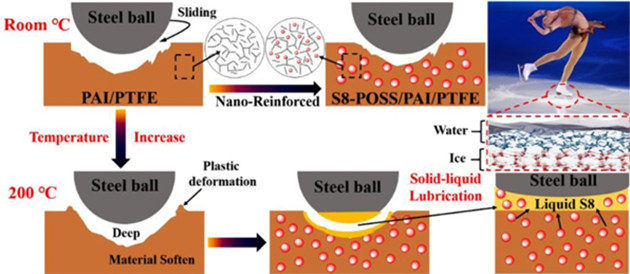Ice-skating is a particularly popular sport, and it is widely believed that ice -skating is possible due to the formation of an intermediate layer of liquid water that forms between a layer of solid ice and the icy surface, which lubricates the skates. Researchers have attempted to simulate this peculiar natural state to achieve low friction and minimal wear.
The Wear and Surface Engineering group at the Lanzhou Institute of Chemical Physics, Chinese Academy of Sciences, has long been committed to the fundamental research and applications of high-performance lubricating and wear-resistant coatings.
Inspired by the solid-liquid composite lubrication state of the contact interface between skates and ice and based on the boundary lubrication theory, the research team has developed a new type of solid-liquid composite lubrication coating with excellent friction reduction and anti-wear properties by means of component modification, resin structure regulation, and liquid phase controlled migration, which broke through the design concept of traditional lubrication coatings.
Researchers used liquefiable orthorhombic sulfur (S8) with reversible dynamic disulfide bonds to modify octavinyl polyhedral oligomeric silsesquioxane (POSS), to obtain a thermally phase-changeable nanocomposite (S8-POSS) with a unique structure. Its self-anchoring effect can effectively improve the mechanical load-bearing capacity of the coating. In addition, the solid-liquid lubrication and self-healing effect are realized by relying on the thermal phase-change during the friction process, which effectively reduces the coating friction coefficient and wear rate (Fig. 1).

Fig. 1 Solid-liquid composite lubrication mechanism of the coating during simulated skating
In addition, the research team achieved matrix strengthening by diazotization of the GO surface, anchoring the modified GO, and in situ polymerization of polyurethane (Fig. 2), which reduced the friction coefficient of the composite coating by 90%, reduced the wear rate by an order of magnitude, and extended the wear life by about 5 fold. Combining the aforementioned strengthened matrix with liquid silicone oil further reduces the friction coefficient of the ternary composite coating by 30% and prolongs service life by 1.35 fold. Compared with the composite coating without the reinforced matrix, the friction coefficient was reduced by 60% and the wear life was increased by up to 5 fold thanks to the silicone oil. This potentiation was more palpable at high loads and high speeds (Fig. 3).

Fig. 2 GO modification and anchoring effects

Fig. 3 Tribological properties of solid-liquid composite coating
The aforementioned coatings break through the material selection restrictions of traditional graphite and molybdenum disulfide lubricating coating, and compared with most of the current solid-liquid composite work through microcapsules, the preparation method is simple, convenient, and low cost, and the friction coefficient is lower, which affords a higher engineering application value.
Similar results were published in the Chemical Engineering Journal (2021, 425:130006), Composites Part A: Applied Science and Manufacturing (2021, 148:106473) and Progress in Organic Coatings (2020, 145:105667). And 2 national invention patents were applied for (CN 202011158727.4; CN 201910305224.6) with 1 item has being authorized (ZL 201910305224.6).
The above work was supported by the National Natural Science Foundation of China.
Contact:
Ma yanjun
Email: mayanjun@licp.cas.cn
Lanzhou Institute of Chemical Physics


